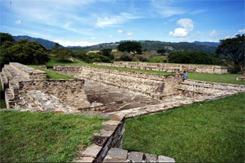








Geoarchaeology is the application of concepts and methods of the earth sciences (especially geology, geomorphology, hydrology, sedimentology, pedology, and exploration geophysics) to archaeological problems. It provides evidence for the development, preservation, and destruction of archaeological sites, and for regional-scale environmental change and the evolution of the physical landscape, including the impact of human groups. Our group focuses on Archaeometry, the study of archaeological and art history materials using the techniques of the physical and biological sciences, including radiometric dating and the chemical and isotopic analysis of artefacts.
Our projects include:
• determining the geological sources for the prehistoric ceramic traditions in the Grand Canyon area of northern Arizona, in order to assess the index-ware-based definitions of the Kayenta Anasazi and Cohonina archaeological groups and models of their interaction
• evaluating TIMS and SHRIMP isotopic techniques for ceramic provenance studies
• constraining compositional and morphological attributes of black paints on Anasazi ceramics using surface analysis by XPS
• petrographic studies of amorphous unfired brick from the Presidio de San Francisco to determine where material for adobe brick was quarried, as a way of assessing whether its manufacture was centralized and standardized as the population within and surrounding the Presidio grew
• developing rapid and low-cost analytical protocols that would allow archaeologists to analyze many more obsidian samples, to better assess temporal shifts in source, and to determine whether different types of obsidian are associated with ceremonial and utilitarian uses, and with knapping traditions or industries
• studying obsidian from Çatalhöyük, the world-famous site in central Anatolia that was occupied 7400-5500 cal BC, not only with regard to its functional capabilities and daily household use, but also in terms of the community’s role in its long-distance exchange and its symbolic properties• using the presence of far-traveled obsidian at the UNESCO World Heritage site of Chavín de Huántar, which, dating to 1500-500 BC, may represent the locus of the development of authority and social complexity in the central Andes, and to determine the extent and nature of Chavín’s contacts with contemporary ceremonial centers, both in the highlands and on the coast, to determine whether it was the source, or perhaps simply exemplar, of the first pan-regional ideological system to develop in Peru
Additional Information:
The Stanford Archaeology Center offers a graduate program in Archaeology.
Students are admitted to and get their degrees in the participating departments, which include G&ES, but take part in courses and activities designed for graduate students with interests in Archaeology. Professor Mahood is a member of the Executive Committee of the Stanford Archaeology Center.

Mixco Viejo Archeological Site, 13 km south of Pachalúm, Guatemala.

Maya ruins at Quiriguá, exhibiting some of the most well-preserved Mayan stelae (pillars), Guatemala.

Zoomorphic carving in sandstone from the Classic Maya
site of Quirigua in the Peten of Guatemala. (Photo by Sid Carter)
